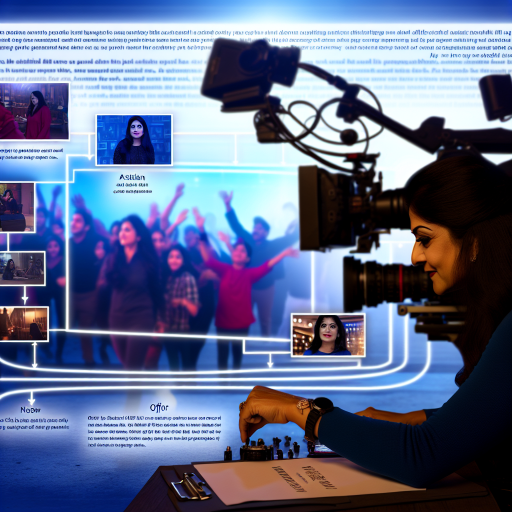Introduction
A creative director plays a vital role across many industries.
They lead artistic vision and project execution.
Their influence spans advertising, fashion, film, and technology.
These professionals shape brand identities and drive innovative campaigns.
Companies rely on creative directors to navigate competitive markets effectively.
Creative directors excel in team collaboration and strategic thinking.
They guide designers, writers, and marketing experts.
By fostering a creative environment, they encourage fresh ideas and innovative solutions.
This synergy fuels brand differentiation and audience engagement.
In today’s fast-paced world, brands need to stand out.
Creative directors ensure that uniqueness and consistency define a brand’s voice.
The significance of creative directors goes beyond mere aesthetics.
They play a key role in storytelling, turning concepts into compelling narratives.
Through visual elements and messaging, they capture audience attention.
Their work enhances emotional connections with consumers.
This engagement drives loyalty and boosts sales.
Industries such as branding and advertising consistently seek creative directors.
These sectors thrive on innovative marketing strategies.
From developing campaigns to overseeing their execution, creative directors are indispensable.
In the fashion industry, they dictate trends and inspire collections.
Transform Your Career Today
Unlock a personalized career strategy that drives real results. Get tailored advice and a roadmap designed just for you.
Start NowTheir vision influences seasonal launches and brand collaborations.
In the film and entertainment realm, creative directors head production teams.
They turn scripts and ideas into visual masterpieces.
Their expertise shapes the overall aesthetic, ensuring a cohesive final product.
Meanwhile, the tech industry also employs creative directors.
They oversee user experience design, blending functionality with engaging visuals.
Creative directors are essential for driving innovation and branding.
Their ability to lead creative teams and channel ideas into tangible results creates lasting impacts.
As industries evolve, the demand for skilled creative directors continues to grow.
Their unique perspectives and leadership will remain invaluable in shaping future trends.
Creative Directors in Various Industries
Creative directors play a pivotal role in shaping brand identities.
They guide creative vision across various sectors.
Their expertise is highly sought after across different fields.
In this section, we explore the top industries hiring creative directors.
We will also discuss what makes each of them unique.
Advertising and Marketing Agencies
Advertising and marketing agencies are at the forefront of hiring creative directors.
They rely on these professionals to craft compelling narratives.
These professionals deliver innovative campaigns.
Here are some key aspects of this industry:
- Strategy Development: Creative directors develop overarching strategies for campaigns.
- Team Leadership: They lead multidisciplinary teams, including designers, copywriters, and strategists.
- Client Interaction: Creative directors frequently engage with clients to understand their visions.
- Trend Analysis: They stay informed about industry trends and competitor strategies.
- Performance Metrics: Agencies often measure the success of campaigns.
Fashion and Beauty Industry
The fashion and beauty industry thrives on creativity.
Transform Your Career Today
Unlock a personalized career strategy that drives real results. Get tailored advice and a roadmap designed just for you.
Start NowThis sector constantly seeks innovative ideas from creative directors.
Here are some key points:
- Brand Identity: Creative directors shape brand identities through visuals and storytelling.
- Collection Development: They oversee the development of fashion collections.
- Visual Merchandising: Creative directors ensure appealing displays in stores and online.
- Collaboration: They often collaborate with photographers, models, and makeup artists.
- Market Trends: Being aware of market shifts is crucial.
Film and Television Production Companies
The film and television sectors need creative directors to bring stories to life.
Their vision greatly influences the overall aesthetic of productions.
Here are some key insights:
- Concept Development: Creative directors help develop concepts for films or series.
- Visual Storytelling: They craft the visual narrative of a production.
- Talent Coordination: Creative directors coordinate with writers, directors, and actors.
- Post-Production Oversight: They supervise post-production processes, such as editing and visual effects.
- Audience Engagement: Understanding audience preferences shapes creative direction.
Tech Companies and Startups
In today’s digital landscape, tech companies are increasingly investing in creative directors.
These professionals are essential in shaping user experiences.
Important considerations include:
- User Experience: Creative directors focus on user-centric designs.
- Branding Strategies: They develop and implement branding strategies for tech products.
- Cross-Disciplinary Teamwork: Creative directors collaborate with engineers and marketers.
- Content Creation: They oversee the creation of content to support product launches.
- Adaptability: The tech industry evolves rapidly.
Non-Profit Organizations
Non-profit organizations often require creative directors to communicate their missions effectively.
These professionals play a crucial role in storytelling.
They also enhance community engagement.
The significance includes:
- Mission Communication: Creative directors translate a non-profit’s mission into compelling narratives.
- Fundraising Campaigns: They design creative fundraising concepts and materials.
- Brand Awareness: Building awareness about a cause is essential.
- Volunteer Engagement: They create initiatives to engage volunteers creatively.
- Social Media Strategies: Non-profits leverage social media to reach wider audiences.
Creative directors are integral to various industries.
They drive innovation, foster collaboration, and shape creative visions.
As organizations recognize the value of creativity, the demand for skilled creative directors will continue to grow.
Role of Creative Directors in Developing Advertising Campaigns
Creative directors are responsible for leading creative teams in concept development.
They generate ideas that resonate with target audiences.
These ideas often form the foundation of advertising campaigns.
Here are the main responsibilities of creative directors:
- Concept Development: Creative directors brainstorm and develop original ideas. They align these ideas with the brand’s objectives.
- Team Leadership: They guide graphic designers, copywriters, and artists. Effective leadership fosters collaboration and innovation.
- Client Collaboration: Creative directors work closely with clients. They ensure the brand’s vision and messaging are accurately represented.
- Project Oversight: They oversee projects from conception to deployment. This includes timelines, budgets, and quality control.
- Market Research: They analyze trends and competitor strategies. This research informs campaign strategies, leading to more effective messaging.
Campaigns vary in scale and complexity.
Transform Your Career Today
Unlock a personalized career strategy that drives real results. Get tailored advice and a roadmap designed just for you.
Start NowCreative directors tailor their approach based on project requirements.
Whether launching a new product or revitalizing a brand, their impact is significant.
Importance of Creative Direction in Brand Messaging
Creative direction shapes how brands communicate with their audiences.
It establishes a unique voice and personality that differentiates them in the market.
Effective brand messaging captivates customers and builds loyalty.
Consider the following reasons why creative direction is vital for brand messaging:
- Consistency: Creative directors ensure branding remains consistent across all platforms. This consistency reinforces recognition and trust.
- Emotional Connection: They craft messages that resonate emotionally. Emotional connections enhance customer loyalty and engagement.
- Clear Messaging: Creative directors distill complex ideas into clear messages. Clear messaging helps audiences understand the brand’s value.
- Storytelling: They utilize storytelling techniques to make brands relatable. Compelling stories captivate audiences and encourage sharing.
- Visual Identity: Creative directors develop a brand’s visual identity. This includes logos, colors, and typography, which convey the brand’s essence.
In today’s fast-paced world, consumers are bombarded with information.
Unique and innovative brand messaging cuts through this noise, capturing attention.
Creative directors ensure that branding is memorable and impactful.
Customer Engagement and Creative Direction
Customer engagement is essential for brand success.
Creative directors play a crucial role in enhancing this engagement through innovative ideas.
Engaging campaigns not only attract new customers but also retain existing ones.
Here are some strategies creative directors use to boost customer engagement:
- Interactive Content: Creative directors encourage the use of interactive content. Quizzes, polls, and videos create more engaging experiences.
- Social Media Strategy: They develop creative social media strategies. This includes eye-catching visuals and compelling copy tailored for different platforms.
- Personalization: Creative directors advocate for personalized messaging. They tailor campaigns based on customer behavior and preferences.
- User-Generated Content: They promote user-generated content initiatives. Engaging customers to share their experiences enhances authenticity and trust.
- Influencer Collaborations: Creative directors leverage influencer partnerships. Collaborations with popular figures enhance credibility and reach.
Ultimately, effective creative direction transforms a brand’s relationship with its audience.
Engaging experiences convert casual viewers into loyal advocates.
Creative Directors as Key Players in Brand Success
In advertising and marketing agencies, creative directors are indispensable.
Their role in developing compelling advertising campaigns is vital for success.
They lead teams, foster innovation, and ensure brand messaging aligns with goals.
Moreover, their strategic focus on customer engagement drives brand loyalty.
By creatively addressing audience needs, they enhance a brand’s presence in the market.
Transform Your Career Today
Unlock a personalized career strategy that drives real results. Get tailored advice and a roadmap designed just for you.
Start NowAs industries evolve, the demand for skilled creative directors will continue to rise.
The influence of creative directors in advertising agencies extends beyond mere aesthetics.
They shape how brands connect with their audiences and contribute significantly to a brand’s overall success.
With their guidance, brands can navigate the complexities of the marketplace and emerge successfully.
Uncover the Details: The Impact of Technology on Film Production
Fashion and Beauty Industry
In the vibrant world of fashion and beauty, the role of a creative director stands central.
These visionaries wield significant influence over brand identity and visual aesthetics.
Their creative insight informs every aspect of a brand’s image, making them crucial to its success.
Understanding their impact requires an exploration of their multifaceted responsibilities within this dynamic industry.
How Creative Directors Shape Brand Identity
Creative directors play an essential role in defining brand identity.
They develop a cohesive vision that connects with consumers on multiple levels.
Here are several ways they achieve this:
- Defining Core Values: Creative directors clarify what the brand represents.
- Creating Visual Guidelines: They develop a visual language that includes logos, color palettes, and typography.
- Storytelling: Through strategic narratives, creative directors craft compelling stories.
- Innovation: They push creative boundaries by exploring new ideas and techniques.
- Consumer Insights: By understanding consumer behavior, they shape messages that resonate.
Each of these areas influences how consumers perceive a brand.
A cohesive and compelling identity can attract and retain loyal customers.
The Impact of Creative Direction on Runway Shows
Runway shows are a hallmark of the fashion industry, showcasing designs and setting trends.
Creative directors are pivotal to the success of these events.
Here’s how their influence manifests:
- Theme Development: Creative directors develop themes that unify collections and presentations.
- Choreography and Staging: They oversee the choreography of models on the runway.
- Music Selection: The choice of music enhances the atmosphere.
- Lighting Design: Creative directors collaborate with lighting designers to set the mood.
- Integration of Multimedia: They may incorporate video or digital displays.
The creative director’s vision transforms a simple presentation into a powerful brand statement.
Each element works synergistically to leave an indelible impression.
The Role of Creative Direction in Ad Campaigns
Ad campaigns serve as a direct link between brands and consumers.
Transform Your Career Today
Unlock a personalized career strategy that drives real results. Get tailored advice and a roadmap designed just for you.
Start NowCreative directors shape these campaigns to convey messages effectively.
Their responsibilities include:
- Concept Development: They conceptualize overarching campaign ideas that align with the brand’s identity.
- Visual Storytelling: Creative directors craft visually compelling stories through imagery and design.
- Copywriting and Messaging: They often collaborate with copywriters to align visual and verbal messaging.
- Target Audience Engagement: By understanding the target demographic, they tailor campaigns to resonate.
- Evaluation and Analysis: After a campaign’s launch, creative directors analyze its effectiveness.
Ad campaigns drive consumer awareness and can significantly influence sales.
A well-executed campaign speaks to consumers and inspires action.
Influence on Product Design
Creative directors significantly influence product design in the fashion and beauty sectors.
Their vision extends to the very products that consumers purchase.
Consider the following aspects:
- Conceptualization: They oversee the initial concept phase for new products.
- Material Selection: Creative directors often make critical decisions regarding materials used.
- Functionality: They ensure that products are both aesthetically pleasing and functional.
- Collaboration with Designers: Creative directors collaborate closely with fashion and beauty designers.
- Market Trends: By monitoring market trends, they adapt product designs to remain relevant.
The creative vision of directors significantly impacts how consumers perceive and value products.
Each product launch is an opportunity to reinforce brand identity.
You Might Also Like: The Future of Corporate Training in Communications
Role of Creative Directors in Storytelling
Creative directors are essential in crafting narratives that captivate viewers.
They guide the overall vision of a project and shape how stories unfold on screen.
- They conceive ideas that form the backbone of scripts.
- They develop themes that resonate emotionally with viewers.
- They establish the tone and pacing of the narrative.
- They work to create multi-dimensional characters that flourish throughout the story.
- They draw inspiration from various art forms to enrich narratives.
Storytelling involves numerous elements that come together cohesively.
Creative directors ensure that all aspects work harmoniously.
They merge dialogue, cinematography, and performances to create compelling experiences.
Visual Design and Aesthetics
Visual design is another area where creative directors excel.
They understand the power of imagery and its emotional impact.
Their vision translates a script into stunning visuals.
- They establish the aesthetics, including color palettes and visual motifs.
- They select locations and sets that enhance the story’s mood.
- They collaborate closely with cinematographers to craft the look of each scene.
- They oversee costume design to ensure characters align with the story.
- They integrate special effects on both practical and digital levels.
Through meticulous attention to detail, creative directors create immersive worlds.
Their insights guide the artistic direction of each project, establishing a unique style.
Transform Your Career Today
Unlock a personalized career strategy that drives real results. Get tailored advice and a roadmap designed just for you.
Start NowCollaboration among Creative Directors, Filmmakers, and Production Teams
The success of any production hinges on effective collaboration.
Creative directors must work closely with filmmakers and production teams.
This partnership fosters a unified vision for the project.
Working with Filmmakers
Creative directors often collaborate with producers, writers, and directors.
Here are some key aspects of their collaboration:
- They align on the project’s core vision and objectives.
- They brainstorm concepts to overcome creative challenges.
- They offer feedback that helps refine the script and story.
- They engage in constructive discussions during pre-production planning.
- They ensure that all creative choices support the film’s narrative structure.
Fostering open lines of communication enhances the creative process.
Together, they navigate complex tasks and make crucial decisions effectively.
Collaboration with Production Teams
Creative directors also engage with various production departments.
Their collaboration spans numerous roles that contribute to the project:
- They consult with production designers to translate their vision into tangible designs.
- They collaborate with editors to construct the final cut of the film.
- They work with sound designers to enhance the auditory experience.
- They coordinate with hair and makeup teams to establish character appearances.
- They guide the marketing team in creating promotional materials that align with the film’s vision.
This teamwork strengthens every aspect of the production.
Creative directors are pivotal in ensuring that the creative vision translates through all facets of filmmaking.
The Evolution of the Creative Director Role
The role of the creative director has evolved alongside technological advancements.
With the rise of streaming platforms and digital content, new opportunities arise.
- Creative directors now work on multi-platform narratives, engaging audiences through various mediums.
- They incorporate cutting-edge technology, such as VR and AR, into storytelling techniques.
- They adapt scripts for diverse audiences globally, enhancing relatability.
- They pitch concepts to networks and streaming services, securing funding for innovative projects.
- They embrace social media strategies to build a fanbase prior to release.
This evolution reflects the industry’s continuous growth and innovation.
Creative directors today must remain flexible and adaptable in a rapidly changing landscape.
The Importance of Networking and Industry Reputation
Networking plays a vital role in a creative director’s success.
Building relationships within the industry can lead to new opportunities.
- Attending film festivals can create connections with filmmakers and producers.
- Participating in workshops enhances skills and expands professional networks.
- Engaging with emerging talent fosters collaboration on future projects.
- Utilizing social media allows creative directors to showcase their work and connect with peers.
- Maintaining a strong portfolio highlights their expertise and versatility.
A strong reputation can lead to higher demand for creative directors.
As they navigate the industry, reputation often dictates project choices and opportunities.
Creative Directors and Their Impact on Filmmaking
Creative directors hold an influential position in film and television production companies.
Transform Your Career Today
Unlock a personalized career strategy that drives real results. Get tailored advice and a roadmap designed just for you.
Start NowTheir expertise shapes storytelling and enhances visual design.
The collaboration between creative directors, filmmakers, and production teams is crucial for success.
As the industry continues to evolve, creative directors will play an essential role in innovation and storytelling.
Their passion and vision are key ingredients behind the magic of cinema and television.
Delve into the Subject: Key Differences Between In-house and Agency Publicists

Importance of Creative Direction in User Experience Design
User experience (UX) design plays a crucial role in how consumers interact with technology.
Creative directors shape how users perceive a product by influencing design and user interaction.
Here are some key aspects of their impact:
- Building Intuitive Interfaces: Creative directors ensure that designs are user-friendly. They lead teams to create compelling interfaces that enhance usability.
- Creating Emotional Connections: A well-designed UX establishes an emotional bond. Creative directors focus on storytelling that resonates with the target audience.
- A/B Testing and Iteration: Creative directors manage testing and iterations. They analyze user feedback, refining designs to elevate the user experience.
- Accessibility Design: Ensuring inclusivity is a priority for creative directors. They advocate for accessible design practices that cater to diverse users.
- Brand Consistency: Creative directors maintain a cohesive user experience. Their vision aligns user interface design with the brand’s identity and mission.
In this way, tech companies can craft an experience that encourages engagement and loyalty.
Creative directors facilitate innovative approaches to user experience that captivate and retain customers.
Branding Strategies in a Competitive Market
Tech startups and companies operate in crowded environments.
They often need to establish unique brand identities.
Creative directors are integral to crafting and communicating these identities effectively.
Here are a few ways they contribute:
- Defining the Brand Vision: Creative directors articulate the company’s mission and vision. This clarity fosters a strong brand identity that resonates with consumers.
- Developing Visual Assets: They oversee the creation of logos, typography, and color palettes. These elements serve as the foundation of the brand’s visual identity.
- Strategic Messaging: Creative directors shape the voice and tone of the brand. They ensure that messaging aligns with the overall brand strategy.
- Social Media Presence: In today’s digital age, social media is vital. Creative directors design compelling campaigns that engage users across multiple platforms.
- Responsive Marketing: The tech market shifts rapidly. Creative directors craft adaptable marketing strategies that are responsive to emerging trends.
The ability of creative directors to help companies navigate this landscape is invaluable.
By building distinct brands, they ease the path to customer loyalty and market presence.
Creative Directors as Innovators in Tech
Creative directors are not just stewards of design; they are also innovators.
They embrace new technologies and methodologies to bring ideas to life.
Their influence extends far beyond aesthetics.
Here are some reasons they are considered the driving force of innovation:
Transform Your Career Today
Unlock a personalized career strategy that drives real results. Get tailored advice and a roadmap designed just for you.
Start Now- Incorporating Emerging Technologies: They stay updated on cutting-edge tech trends. This knowledge helps brands leverage advancements, enhancing user engagement.
- Fostering Collaboration: Creative directors cultivate collaborative environments. They encourage diverse input from teams, fostering creativity and innovation.
- Emphasizing Prototyping: Rapid prototyping is key to tech development. Creative directors oversee iterative processes that test concepts and refine designs quickly.
- Encouraging a Culture of Experimentation: They advocate for experimentation, allowing teams to explore new ideas without fear of failure.
- Translating Data into Designs: Creative directors utilize data analytics to inform design decisions. They bridge the gap between analytics and creative concepts.
These characteristics underline the critical role creative directors play in fostering innovation.
They help companies keep pace with industry advancements and shifting consumer preferences.
Attracting Top Talent and Collaborations
The presence of visionary creative directors attracts top talent.
People want to work in environments that encourage creativity and push boundaries.
Creative leaders provide just that.
Here are several reasons why they are instrumental in attracting talent:
- Cultivating a Creative Culture: Creative directors nurture environments that celebrate originality. This culture inspires employees and fosters exceptional performance.
- Mentoring and Development: As experienced leaders, they mentor junior staff. This mentorship creates a platform for growth and fosters loyalty.
- Pioneering Industry Standards: Innovative practices established by creative directors often become industry benchmarks. Their leadership advances creativity standards across the sector.
- Collaborative Partnerships: Their vision opens doors for collaborations with other creatives and agencies. These partnerships generate fresh ideas and reinforce brand value.
- Enhancing Brand Reputation: A strong brand reputation attracts high-caliber talent. The position of a creative director significantly influences public perception.
A robust creative direction fosters a magnet-like effect for top talent.
This dynamic ensures ongoing growth and innovation within tech companies.
Creative Directors in the Evolving Tech Landscape
Creative directors play an essential role within tech companies and startups.
They elevate user experience design and strategic branding.
Their ability to foster innovation, attract talent, and differentiate brands makes them invaluable.
As the tech landscape continues to evolve, the need for inspired creative leadership will only become more pronounced.
Companies that recognize and invest in this talent will not only survive but thrive in this competitive environment.
You Might Also Like: How to Build a Strong VFX Artist Portfolio
Non-profit organizations operate on a unique business model.
They aim to serve the community and drive positive change.
To achieve their goals, they often need the creative expertise of talented professionals.
One of the most crucial roles in this sector is the creative director.
These individuals play a vital role in shaping a non-profit’s image, message, and outreach strategies.
The Role of Creative Directors in Non-Profit Marketing and Fundraising
Creative directors in non-profits manage various aspects of marketing and communications.
Transform Your Career Today
Unlock a personalized career strategy that drives real results. Get tailored advice and a roadmap designed just for you.
Start NowThey ensure the organization’s voice is consistent and compelling across all platforms.
Their responsibilities include:
- Brand Development: Creative directors create a strong brand identity.
- Content Creation: These professionals oversee the creation of engaging content.
- Campaign Management: They design and execute fundraising campaigns.
- Collateral Design: Creative directors oversee the design of promotional materials.
- Collaboration: They work closely with other departments.
How Creative Direction Helps Non-Profits
Creative direction goes beyond marketing tactics.
It can transform how non-profits connect with their audience.
Here are a few ways creative directors help non-profits thrive:
- Raising Awareness: Creative directors craft messages that resonate.
- Engaging Supporters: By using innovative strategies, creative directors engage potential supporters.
- Creating Emotional Connections: Effective storytelling creates an emotional response.
- Utilizing Multimedia: Today, multimedia content captures more attention.
- Building Community Relationships: They identify opportunities for partnerships.
- Providing Clarity: In complex issues, clear messaging is crucial.
Impact on Fundraising Efforts
Fundraising is essential for non-profits, and creative directors play a key role in this process.
Their creative ideas can significantly impact the success of fundraising initiatives.
They utilize various tactics to enhance fundraising efforts:
- Campaign Design: Creative directors design campaigns that are visually appealing and informative.
- Donor Engagement: They develop strategies to keep donors informed.
- Event Marketing: Creative directors help to promote fundraising events.
- Mobile Fundraising: With tech-savvy approaches, they leverage mobile platforms for donations.
- Impact Reports: They create annual reports that effectively highlight success stories.
Engaging the Community
Creative directors are critical in building a community around a non-profit’s mission.
They know how to connect individuals and motivate them to participate.
Engaging the community involves:
- Social Media Strategy: Developing a strong social media presence is vital.
- Volunteer Recruitment: They design campaigns that attract volunteers.
- Partnership Opportunities: Creative directors identify potential partnerships.
- Feedback Mechanisms: Establishing ways to gather community feedback improves strategies.
- Cultural Relevance: Understanding current trends is important in non-profit work.
Examples of Successful Initiatives
Numerous non-profits have successfully utilized creative direction to elevate their missions.
Some notable examples include:
- Charity: Water: Their visually appealing campaigns successfully illustrate the importance of clean drinking water.
- World Wildlife Fund (WWF): WWF engages supporters with captivating visuals of wildlife.
- American Red Cross: Their emergency responses are bolstered by well-designed campaigns.
Creative Directors Influence on Industries
Creative directors play a vital role in shaping the vision of their organizations.
They drive innovation and foster a culture of creativity within teams.
In industries like advertising, entertainment, and fashion, their influence is profound.
These professionals bring concepts to life, ensuring that brands communicate effectively.
They understand market trends and audience preferences, making them essential leaders.
Creative directors excel in storytelling, creating emotional connections with consumers.
Many industries now recognize the unmatched value of creativity.
Transform Your Career Today
Unlock a personalized career strategy that drives real results. Get tailored advice and a roadmap designed just for you.
Start NowIn technology, they enhance user experiences through intuitive design and branding.
Their expertise helps businesses stand out in saturated markets.
As companies seek unique ways to engage consumers, the demand for creative directors remains high.
Aspiring creative directors should seize opportunities in these dynamic fields.
They can build impressive portfolios by collaborating on diverse projects.
Networking with industry professionals can lead to valuable mentorship.
Understanding trends and refining skills will enhance their marketability.
Creative directors have the opportunity to shape the future of brands.
By pushing boundaries, they can create memorable campaigns that resonate with audiences.
It’s essential to stay curious and open to new ideas continuously.
These attributes will fuel both personal and professional growth.
Embracing challenges will ultimately lead to greater success.
The world needs inventive thinkers who can inspire change.
Through persistence and innovation, aspiring creatives can leave a mark.
So, explore these top industries and make your creative vision a reality.
Additional Resources
Creative Director Career Profile – Meadows School of the Arts, SMU
What Can You Do with a Communications Degree? 10 Careers …
[E-Books for Sale]
The Big Book of 500 High-Paying Jobs in America: Unlock Your Earning Potential
$19.99 • 500 High-Paying Jobs • 330 pages
Explore 500 high-paying jobs in America and learn how to boost your career, earn more, and achieve success!
See All 500 High-Paying Jobs of this E-Book
1001 Professions Without a Degree: High-Paying American Jobs You Can Start Now
$19.99 • 1001 Professions Without a Degree • 174 pages
Discover 1001 high-paying jobs without a degree! Unlock career tips, skills, and success strategies for just $19.99!




